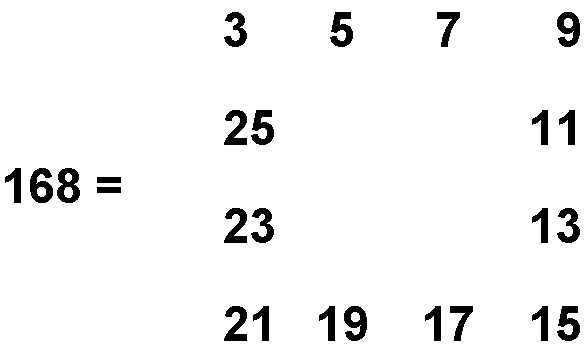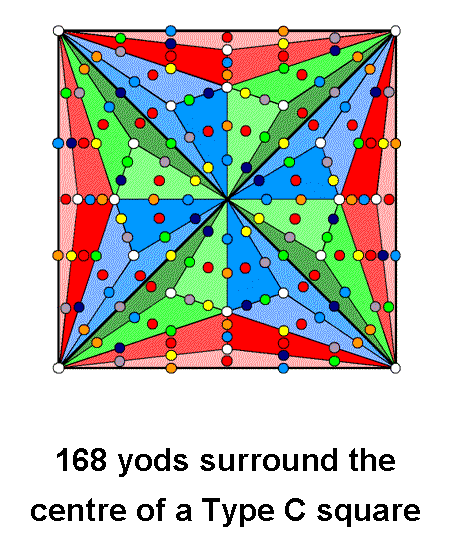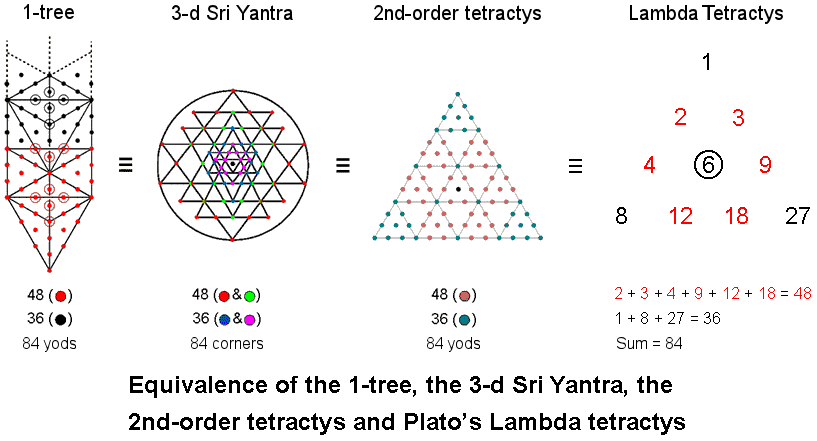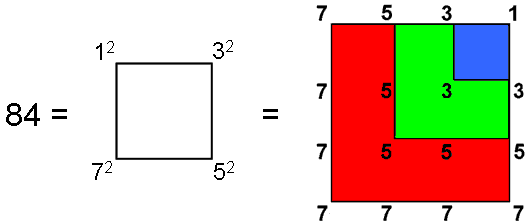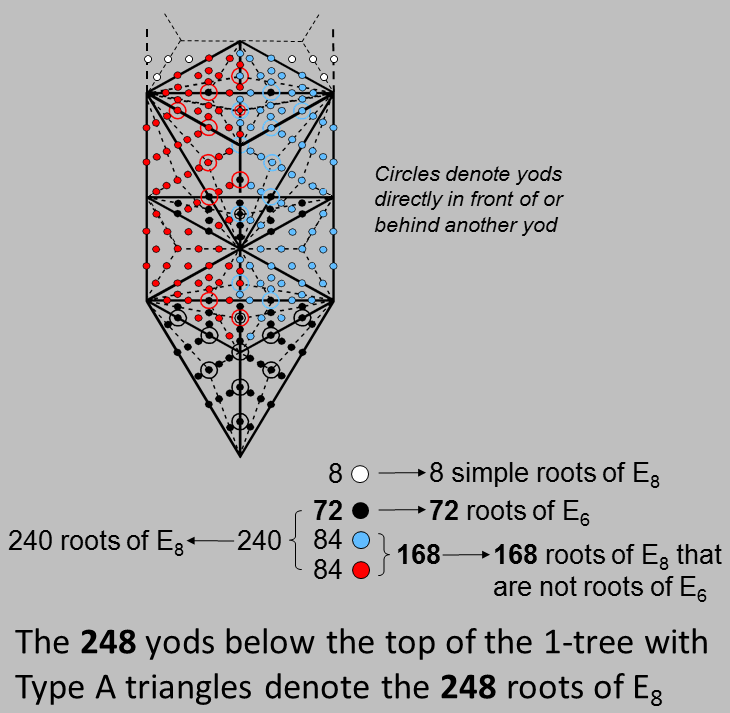
Number of corners (SLs) of Type A triangles in the n-tree ≡ N = 6n + 5.
Number of sides of Type A triangles ≡ S = 16n + 9.
Number of Type A triangles in n-tree ≡ T = 12n + 7.
Inside each Type A triangle are 10 yods. Number of yods in the n-tree with Type A triangles ≡ Y = N
+ 2S + 10T = 158n + 93.
The 1-tree contains (158+93=251) yods. Of these, 11 are SLs, leaving 240 yods. The diagram shows that 4 white yods lie outside the 1-tree below its apex on either side of the central Pillar of Equilibrium. Below the top of the 1-tree are (240+8=248) yods other than SLs. This is the number of roots in the rank-8 exceptional group E8. The 8 white yods outside the 1-tree denote its 8 simple roots (the so-called "zero roots"). The 240 yods other than SLs denote the 240 "non-zero" roots of E8.
The trunk of the Tree of Life consists of the point (Kether), the line (Chokmah-Binah Path), the triangle (Chesed-Geburah-Tiphareth) and tetrahedron (Netzach-Hod-Yesod-Malkuth). The numbers of yods in the trunk are:
| Point |
1 |
| Line |
4 |
| Triangle |
19 |
| Tetrahedron |
56 |
| Total = |
80 |
The trunk has (80−10=70) yods other than SLs. The diagram shows them as black dots. The root of the Tree of Life is that part of the Tree of Life whose projection onto the plane containing its two side pillars (the plane containing the (7+7) enfolded polygons of the inner Tree of Life) is their shared root edge. This part is the Path connecting Daath and Tiphareth. Neither lies in the plane of the polygons. But the two hexagonal yods lying on this Path project onto the two hexagonal yods in the root edge. They, too, are shown as black dots and may be identified as the black yod inside the red circle on the Daath-Tiphareth Path and as the black circle surrounding the black yod at the centre of the triangle in the trunk. This is shown as a circle because it is a hexagonal yod on the line connecting Daath and Tiphareth, which lies above the plane of this triangle, whose centre therefore lies directly below the hexagonal yod. The 72 black yods other than SLs in the root & trunk denote the 72 roots of E6, an exceptional subgroup of E8. The remaining (240−72=168) yods belong to the branches of the 1-tree. They can be divided into two equal sets of 84 yods (red or blue), the 20 yods aligned with the central Pillar of Equilibrium being divisible into two sets of 10 red or or blue yods. The 168 red or blue yods denote the 168 roots of E8 that are not roots of E6. The structural distinction between the branches of the 1-tree and its trunk and root generates the 72:168 division that is characteristic of other holistic systems embodying the number 240 and which manifests in the group theory of the E8×E8 heterotic superstring as the breakdown of the symmetry of E8 into that of E6.
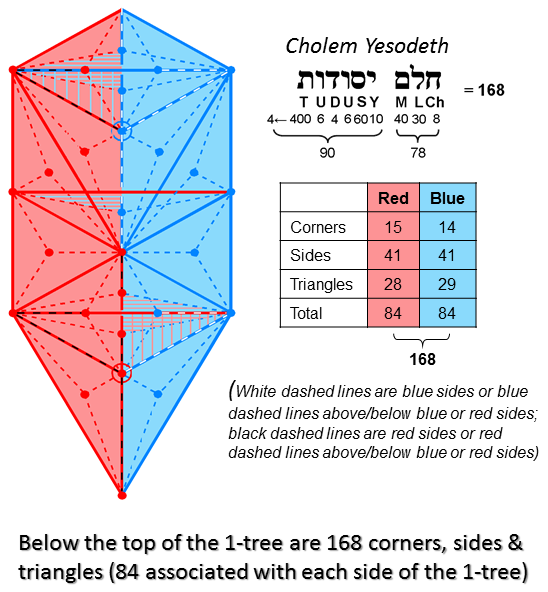
|
|
|
|
The n-tree has (12n+7) triangles with (6n+5) corners and (16n+9) sides. Inside
each triangle when it is Type A are 3 triangles with 3 internal sides & one shared corner.
Number of corners of 3×(12n+7) triangles in the n-tree = 6n + 5 + 12n + 7 = 18n + 12.
Number of their sides = 16n + 9 + 3×(12n+7) = 52n + 30.
Number of triangles = 3×(12n+7) = 36n + 21.
Total number of geometrical elements = 106n + 63.
The 1-tree is the lowest of any set of overlapping Trees of Life. It has 169 geometrical elements, where
169 = 132 = 1 + 3 + 5 + 7 + 9 + 11 + 13 + 15 + 17 + 19 + 21 + 23 + 25.
They comprise 30 corners & 82 sides of 57 triangles. Below the apex of the 1-tree are 168 geometrical elements, where 168 is the number value of Cholem Yesodoth, the Mundane Chakra of Malkuth. As shown in the diagram opposite, associated with each half of the 1-tree are 84 geometrical elements. As 6 red corners line the central Pillar of Equilibrium, the left-hand side has (84−6=78) geometrical elements other than corners aligned with or lying on the axis that divides the 1-tree in half. The right-hand side has (84+6=90) geometrical elements, including all corners on this axis. 78 is the number value of Cholem and 90 is the number value of Yesodoth. The number 168 is the sum of the first 12 odd integers after 1. They form a square when 4 successive odd integers are assigned to each of its 4 sides. Symbol of the Tetrad, the square arithmetically determines how many geometrical elements are needed to construct the 1-tree, starting with the mathematical point at its apex. The square also determines the 1-tree in a purely geometrical way because 168 yods are needed to construct the latter from tetractyses, starting from the centre of a Type C square. As the Type C square is the fourth in the sequence:
square → Type A square → Type B square → Type C square → ....,
this embodiment of the superstring structural parameter 168 is an illustration of the Tetrad Principle at work (see Article 1).
The diagram opposite displays the points, lines & triangles that make up the 1-tree. An equal number (84) of geometrical elements (although not the same numbers of each type) can be associated with the left-hand and right-hand sides of the 1-tree. Every geometrical element in one half of the 1-tree is the mirror image of its counterpart in the other half when the plane of the mirror passes through the central Pillar of Equilibrium at right angles to the plane containing its two side pillars. Geometrical elements lying in this mirror are their own mirror image. Corners lying in the plane of the mirror that bisects the kite-shaped Upper Face are assigned to the right-hand side; those in the mirror that are within the Lower Face are assigned to the left-hand side. Triangles that straddle both sides are assigned to the right-hand side if they are part of the Upper Face and to the left-hand side if they belong to the Lower Face. White dashed lines are sides directly above or below another side that are assigned to the right-hand side; black dashed lines are sides above or below another side that are assigned to the left-hand-side. In order to distinguish a triangle coloured red or blue that partly lies over or behind a triangle of a different colour, the part of the triangle that overlaps another one is shown shaded with either horizontal or vertical lines.
